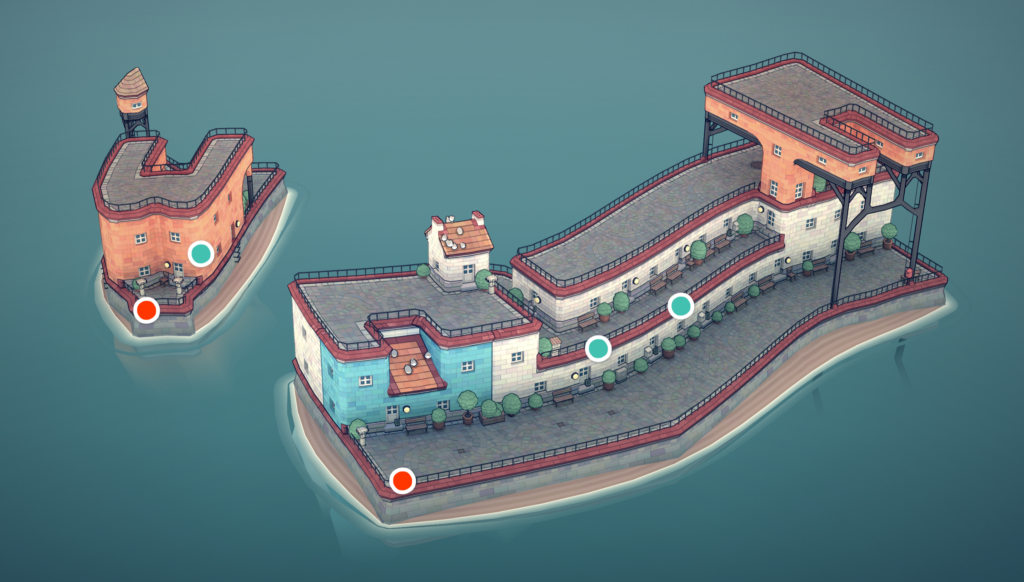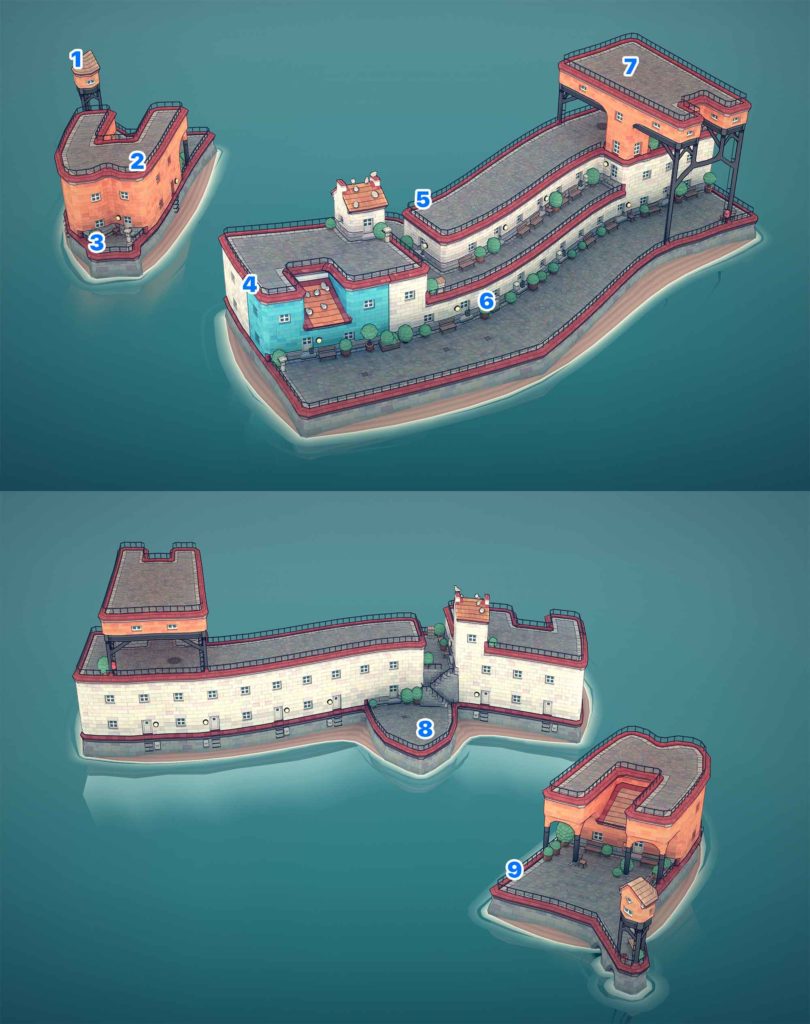Outpost 5990-C4 Glynwich was one of the gap filler sites for the ARC radar network erected by Air Defense & Early Detection to cover the Glynwich, Glynwich Port, Aeddra, and Spuyvel regions. 5990-C4 was occupied by the Air Force from 1951 through 1966, before being converted to lodging for personnel participating in local naval training exercises. In 1977, it was classified as a “storage facility”, although it seems to have never been used as one, and remained empty for the next twenty years.
Often, military facilities that were no longer used but would be expensive to remove are classified as storage sites. This designation not only absolves the responsible party from any immediate duty to remove them, but sometimes functions as a budget booster, allowing the branch to claim more funding for “infrastructural needs”.
This trick is especially favored by Marine Patrol and Air Force, probably because both branches maintain sites in remote areas where removal would be problematic. Marine Patrol at one point operated no less than 2,470 such “storage facilities”; these were known among naval personnel as “Herrick’s closets” after Naval Director Adm. John E. Herrick, although the process did not originate with him and has been in common use for at least 75 years.
During that time, it seems, 5990 was occupied by unknown residents for at least two years.
In 1978, contractors responsible for removing the last of the site equipment arrived to find the floors of several rooms inexplicably covered with two feet of seaweed, an undertaking that they believed would have taken a great deal of effort. There had been no massive weather events that could have resulted in such a ////, and furthermore, 5990 showed no signs of flooding. One of the affected rooms contained pumping machinery and other electrical systems. All of these still functioned properly.
Surveying the interior of the station, Marine Patrol investigators found traces of an oily residue that was ultimately identified as a mixture of organic ocean materials, plankton, liquified plant matter, and

Green dots: rooms with seaweed or residue
. Biologist Steven Sears notes that this amalgam of substances is typically found on the undersides of some deep-sea creatures—daggerfin sharks in particular—and cannot explain why it would have been found on surfaces in 5990, especially since that facility was never used for deep-sea operations.
Map

What particularly attracted attention however, especially among the more conspiracy-minded, was the discovery of two intricate wooden carvings of humanoid creatures: another instance of the phenomenon known as the “Glynwich Dolls”.
Since the late 1940s, seafarers—mostly Marine Patrol, maintenance staff, and rigsmen—have reported finding strange, doll-like objects on remote and unoccupied facilities in the Glynwich/South Aeddra region, commonly referred to as the GSA Circle. These are carved rods of driftwood, typically 6–18 inches in length, that appear to have a crude—often described as “grotesque”—face in the center, surrounded by indeterminate details that may be intended to represent hair. Who creates them, and how they come to be on places that are typically unoccupied and difficult to access, is currently unknown.

Anthropologists have consistently expressed an interest in the phenomenon. Professor Rachel Antegga from the University of Christchurch’s Visual & Historical Culture Program believes the style of the dolls she has seen is similar to Nuvik and Kiami art, but there is no other known evidence that either society was active in the GSAC Circle. Antegga has said that the task of determining their origin would be made easier if she had access to at least three of them, and speculates that the dolls may have entered the ocean from a single source and become scattered, rather than continually being produced by some unknown party.
The study of the dolls is made more difficult by the fact that discussion of them is considered taboo among those most likely to find them. Those who report finding Glynwich Dolls have described being mocked, ostracized, or otherwise stigmatized as gullible or extreme. The official position of Marine Patrol is that the phenomenon does not exist, and the recovered objects are an unrelated collection of driftwood and ocean trash. Marine Patrol investigators acknowledge that while some servicemembers have recovered items that appear to be hand-crafted toys or pieces of art, there is little evidence to suggest any coordinated presence behind them.
In 1995, following a feature about the dolls on Newsline4, naval investigator Charice Richards was quoted as saying that
“…doing what we do, you know, we find objects all the time that we’re not really sure where they came from…you go out on one of these remote places and one of the first things you have to do is, you pull the junk out of the pilings and pipes and stuff. You even find ocean objects stuck on roofs and antennas. It gets blown there. Maybe someone wants to say that, you know, some unknown party climbed up there and put it there, but the wind does some pretty crazy stuff…
And a lot of it’s just garbage or driftwood or something. A lot of it’s things like toys and objects and stuff that’s been wandering around the ocean for months or maybe years…It gets degraded, worn down, objects get turned into these really weird things just from being exposed to sunlight and salt water and wind for half a year. We pulled a mannekin off one of our forward docks once and the thing looked like some kind of corpse or creepy thing, you know what I’m saying? Holes where the eyes were, skin discolored, mouth was all blackened from stuff…but it was just garbage that had been in the sea too long.
And I’m not for a second trying to call into question the credibility or courage of our serving members, but you know, I spent a lot of time out in the middle of the ocean. A lot of time. I think it does something to your mind out there…you see things you wouldn’t maybe see. And it doesn’t surprise me that you could find driftwood or an old doll and maybe see a face or something in it…that’s how people are wired. We see things like that.
That did little to dissuade those who believed they had found dolls from insisting that what they had found was neither garbage nor oddly worn driftwood. In a 1998 book, cryptozoologist Christopher Georges detailed what he described as a Marine Patrol coverup, reprinting internal communications in which naval staff discussed the issue, appeared to acknowledge that the dolls probably did originate from a single source, and emphasized the need to continue downplaying the matter of the dolls, with one participant, whose name was obscured, saying that:
“…[people] have been running across the things for as long as I’ve been here. There might well be some nomadic tribe, maybe even a single ship that’s leaving them. I would agree, however, that the hysteria surrounding this issue has gotten out of proportion, and any official acknowledgment of the matter is going to give the nutjob stuff more credibility than is warranted. I don’t think [Marine Patrol] should be any more involved in this than we need to be…”
Subsequently, the number of people willing to discuss Glynwich Dolls—or even acknowledge finding them—is relatively small. Besides being discouraged by potential stigma, many of those who find Glynwich Dolls are deeply unsettled by them, often destroying them. In 2002, one Marine Patrol veteran, Cpl. David Haskell, discussed dolls that he and other naval personnel found throughout the late 1950s and early ’60s on mid-ocean facilities, all of which were in the Glynwich or South Aeddra circles, and were either remotely operated or rarely visited:
“…you’d run across them, not frequently, but enough that you could say you found one of those goddamned dolls and anyone in that group knew what you’d meant. We thought someone [in the unit] was doing it, as a joke, but people came and went and there were always the goddamned dolls…
Later, I got reassigned to Meridian [another marine district] and there wasn’t anybody I knew over there. And I found one of the things three weeks later…I’d say it was about a foot-long driftwood pike, end sharpened, and one of those faces hacked into the middle of it. There was no question. It was the same damned thing…the bugged-out eyes, the nostrils, bits of shell rammed into it for teeth…it looked like a damned corpse. I burned that thing, let me tell you. I don’t care what it is. And when one of my buddies picked one out of the water later, we burned that one too…”
sadfdsfdsaf
The discovery of the dolls on 5990 was notable because it is the only known instance in which Marine Patrol has released a
Following the cleaning of the facility,
Going by close inspection of the cuts, they do not believe that metal tools were used, suspecting that the items may have been carved with sharpened shell or rock. Microscopic fragments of calcium in the wood later confirmed the shell theory.
Their age is uncertain.
. and the consistency with which they are found in the
The Glynwich Dolls have been
named for the first documented
Naval authorities have not commented on where the dolls ultimately wound up.
Several of these objects are believed to be in Marine Patrol storage. Several current servicemembers have said they have been ordered to retain and turn over any such items they encounter.
Who lived in 5990? Naval investigators wonder if the inhabitants may have come from a shipwreck, surviving in the box before being rescued. No one has come forwards to
